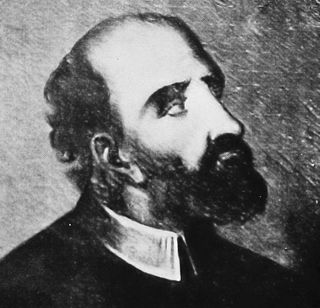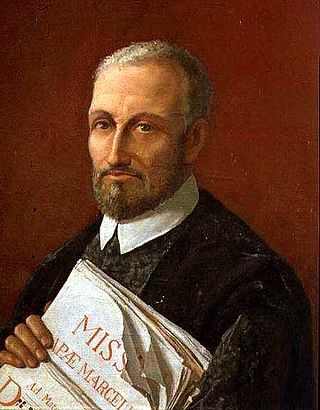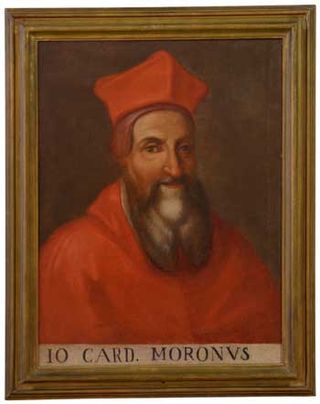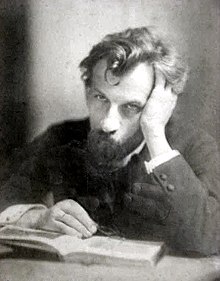
Giovanni Pierluigi da Palestrina was an Italian composer of late Renaissance music. The central representative of the Roman School, with Orlande de Lassus and Tomás Luis de Victoria, Palestrina is considered the leading composer of late 16th-century Europe.

Pope Pius IV, born Giovanni Angelo Medici, was head of the Catholic Church and ruler of the Papal States from 25 December 1559 to his death, in December 1565. Born in Milan, his family considered itself a branch of the House of Medici and used the same coat of arms. Although modern historians have found no proof of this connection, the Medici of Florence recognized the claims of the Medici of Milan in the early 16th century.

Hans Erich Pfitzner was a German composer, conductor and polemicist who was a self-described anti-modernist. His best known work is the post-Romantic opera Palestrina (1917), loosely based on the life of the sixteenth-century composer Giovanni Pierluigi da Palestrina and his Missa Papae Marcelli.
The Counter-Reformation, also sometimes called the Catholic Revival, was the period of Catholic resurgence that was initiated in response to, and as an alternative to, the Protestant Reformations at the time. It began with the Council of Trent (1545–1563) and largely ended with the conclusion of the European wars of religion in 1648. The similar term Catholic Reformation may also encompass reforms and movements within the Church in the periods immediately before Protestantism or Trent.

Dietrich Fischer-Dieskau was a German lyric baritone and conductor of classical music. One of the most famous Lieder performers of the post-war period, he is best known as a singer of Franz Schubert's Lieder, particularly "Winterreise" of which his recordings with accompanists Gerald Moore and Jörg Demus are still critically acclaimed half a century after their release.

Giovanni Animuccia was an Italian composer of the Renaissance who was involved in the heart of Rome's liturgical musical life. He was one of Giovanni Pierluigi da Palestrina's most important predecessors and possibly his mentor. As maestro di capella of St Philip Neri's Oratory and the Capella Giulia at St Peter's, he was composing music at the very center of the Roman Catholic Church, during the turbulent reforms of the Counter-Reformation and as part of the new movements that began to flourish around the middle of the century. His music reflects these changes.
Ernst Haefliger was a Swiss tenor.

Helen Jeanette Donath is an American soprano with a career spanning fifty years.

Doctor Faustus is a German novel written by Thomas Mann, begun in 1943 and published in 1947 as Doktor Faustus: Das Leben des deutschen Tonsetzers Adrian Leverkühn, erzählt von einem Freunde.

The Sistine Chapel Choir, as it is generally called in English, or officially the Coro della Cappella Musicale Pontificia Sistina in Italian, is the Pope's personal choir. It performs at papal functions in the Sistine Chapel and in any other church in Rome where the Pope is officiating, including St. Peter's Basilica. One of the oldest choirs in the world, it was constituted as the Pope's personal choir by Pope Sixtus IV. Although it was established in the late 15th century, its roots go back to the 4th century and the reign of Pope Sylvester I.

Missa Papae Marcelli, or Pope Marcellus Mass, is a mass sine nomine by Giovanni Pierluigi da Palestrina. It is his best-known mass, and is regarded as an archetypal example of the complex polyphony championed by Palestrina. It was sung at the papal coronation Masses.

Karl Erb was a German tenor who made his career first in opera and then in oratorio and lieder recital. He excelled in all these genres, and before 1920 gave classic performances of key roles in modern works, and created lead roles in those of Hans Pfitzner. He was the first husband of Maria Ivogün and was considered by many the ideal Evangelist in Bach's St Matthew Passion.

Maria Ivogün was a distinguished soprano singer of Hungarian origin. She was an especially outstanding interpreter of the works of Mozart: her recording of the aria of the Queen of the Night became legendary.

Julius Patzak was an Austrian tenor distinguished in operatic and concert work. He was particularly noted in Mozart, Beethoven and in early 20th-century German repertoire.

Domenico Bartolucci was an Italian cardinal of the Catholic Church. He was the former director of the Sistine Chapel Choir and the Accademia Nazionale di Santa Cecilia, and was recognized in the field of music both as a director and a prolific composer. Considered among the most authoritative interpreters of Giovanni Pierluigi da Palestrina, Bartolucci led the Sistine Chapel Choir in performances worldwide, and also directed numerous concerts with the Choir of the Academy of Santa Cecilia, including a tour of the former Soviet Union.

Giovanni Morone was an Italian cardinal. He was named Bishop of Modena in 1529 and was created Cardinal in 1542 by Pope Paul III. As a cardinal, he resided in the Vatican's Apostolic Palace and was consulted by Saint Ignatius, founder of the Jesuits.
Siegfried Lorenz is a German baritone who performs opera, oratorio and Lied. A member of the Komische Oper Berlin and later the Staatsoper Unter den Linden, he made award-winning recordings and appeared as a guest internationally. He has been an academic voice teacher in Berlin and Hamburg.
Carola Nossek is a German operatic soprano and academic voice teacher. A member of the Staatsoper Berlin for two decades, she was awarded the title Kammersängerin. She appeared in world premieres and made several recordings in opera and concert settings.
Heinz Imdahl was a German operatic baritone. A member of the Bavarian State Opera, he performed many leading roles at the Vienna State Opera, and appeared as Beethoven's Pizarro at the Teatro dell'Opera di Roma and Wagner's Hans Sachs at the Philadelphia Opera.

Wolfgang Koch is a German operatic bass-baritone. He is best known for his performances in leading roles in the operas of Richard Wagner.
















